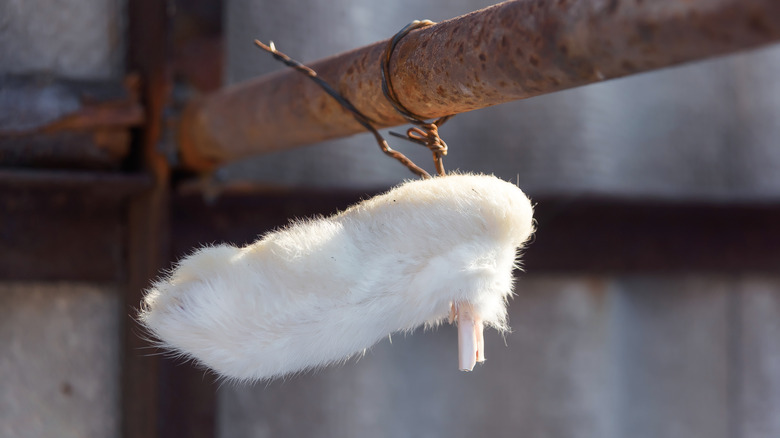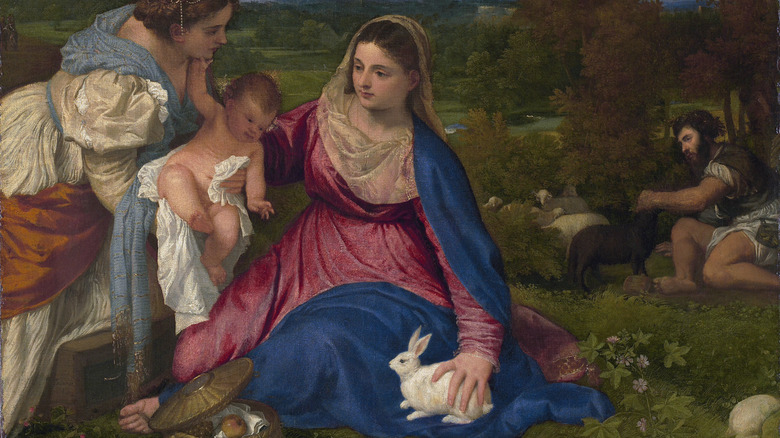Why A Rabbit's Foot Is Considered Lucky
Is there some deep, ancient reason why some people believe that holding on to a dismembered limb brings good luck? After all, rabbits were once associated with the Germanic goddess of the dawn Eostre, whose spring equinox fertility celebration may have paved the way for Easter — the day that the Christian God became alive again. Chinese astrology also includes the rabbit, whereby people born in the Year of the Rabbit are considered "vigilant, witty, quick-minded, and ingenious," as China Highlights says. Ancient Egyptians extolled rabbits, too, which The Local Mystic says were messengers of the goddess of birth and healing, Isis. Elsewhere, the World History Encyclopedia says Unut was referred to as "the rabbit goddess," and Iseum Sanctuary says she became associated with "the opening of the new year, fertility, and the beginning of new life."
And in the present? Rabbits' feet are probably considered lucky because they connect to a variety of ancient superstitions or forgotten folk magick — possibly a European good luck charm and/or African American customs.
A holy sacrifice
History reports that the lucky rabbit's foot might thread its way back to the medieval "Hand of Glory" symbol: The severed hand of a criminal who was hanged to death. As Atlas Obscura explains, a "Hand of Glory" was the right hand of a hanged criminal cut off while the person was still hanging. Originally it wasn't a good luck charm, but a magical token believed to keep people asleep in their home while trespassers burgled the premises.
In explaining the origins of this custom, Atlas Obscura mentions the nearly 3,800-year-old Babylonian Code of Hammurabi and its famous "eye for an eye, a tooth for a tooth" punishment system. This law system made its way into the Bible in the Book of Exodus, verbatim, through the culture of a related Mesopotamian people: the Jews. There's no way to be certain, but it stands to reason that people in Christian medieval Europe — where the Hand of Glory originated — might have attributed some divine power to the body of a person brought to justice before God.
Fast forward hundreds of years to the European Renaissance, and rabbits pop up in artwork like Giovani Bellini's Saint Jerome Reading (1505), Titian's "Madonna of the Rabbit" (1530), and many more. Titian's painting shows Mary, the mother of Jesus, reaching for her baby with one hand and placing her other hand on a white rabbit. The Art Inspector says that the rabbit represents purity and fertility, as well as death, as it burrows in the ground while Jesus rises from it. When combined with existing Hand of Glory beliefs, perhaps — just perhaps — a severed rabbit paw symbolizes a fortuitous, holy sacrifice.
[Featured image by Tiziano Vecellio via Wikimedia Commons | Cropped and scaled]
'Cross-eyed, left-handed, red-headed, bow-legged'
The next clue about lucky rabbit's feet comes from Penn State professor Bill Ellis in his 2014 book "Lucifer Ascending: The Occult in Folklore and Popular Culture." Ellis describes a truly bizarre 1908 account in England that marks the first time in modern, recorded history that we see specific mention of a rabbit's foot connected to luck. The account mentions rabbits' feet shipped from the United States like a magical product, marketed as "the left hind foot of a rabbit killed in a country churchyard at midnight, during the dark of the moon, on Friday the 13th of the month, by a cross-eyed, left-handed, red-headed bow-legged Negro riding a white horse."
It's impossible to pinpoint the origins of this crate of rabbit's feet or if it relates to the Hand of Glory, Renaissance paintings of white rabbits, and Biblical justice. But looking at the description, Ellis suggests that the use of lucky rabbit's feet might have started as a misinterpretation of esoteric customs within Black American communities (via History). It's unknown whether such customs relate to ancestral practices in various African tribes. But it's not incorrect to say that tribal practices typically evolved in the New World in a syncretic way that mixed African heritages with European folklore lingering in North America — like the way New Orleans Vodou blends tribal ritual with Catholicism. That just might be how pieces of sacrificial white rabbits made their way into people's purses.


